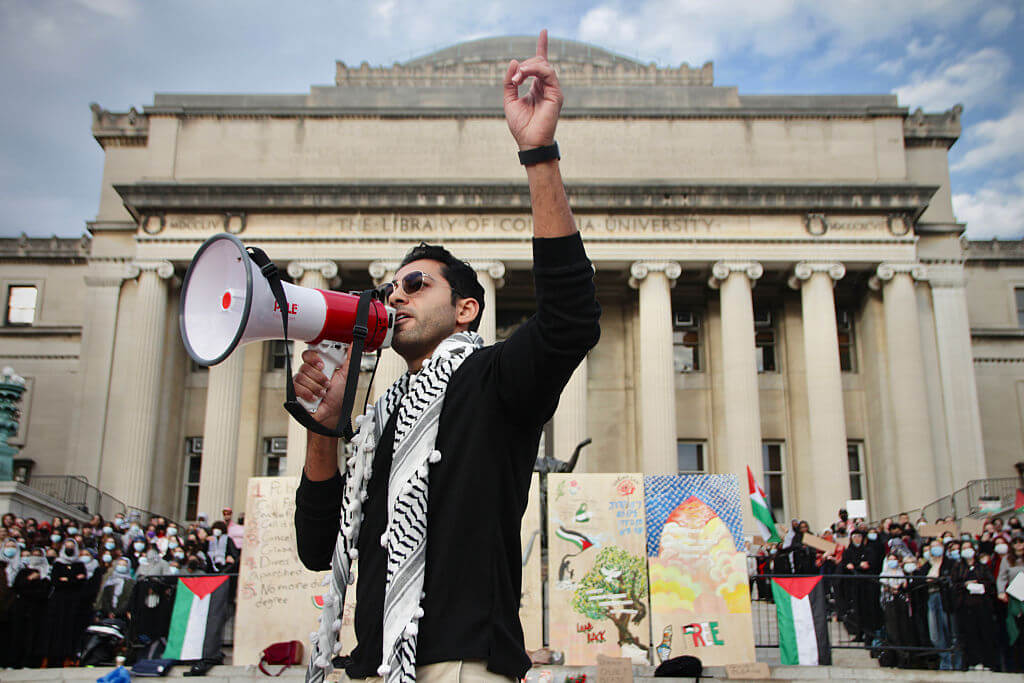
Photo EssayFar-right marches in Europe echo Nazi past
On Holocaust Remembrance Day, photographs showcase how white supremacists around the world embrace fascist forebears
“We Know Our Heroes” banner at far-right march, Kaunas, February 16, 2016. Image by Defending History
Photo EssayFar-right marches in Europe echo Nazi past
On Holocaust Remembrance Day, photographs showcase how white supremacists around the world embrace fascist forebears
When far-right protesters marched with tiki torches through Charlottesville, Virginia in 2017, chanting — among other hateful messages — “Jews will not replace us,” many Americans were stunned and horrified. It seemed reminiscent of another era, another century.
But torchlight marches have hardly disappeared from the public square. Across Europe, far-right forces and white-supremacist movements are gathering for such rallies more frequently, often in broad daylight. And they often orient these gatherings around memorials to Nazi collaborators or anniversaries of World War II atrocities.
Over the past two years, I have been documenting the existence of such monuments and statues, counting about 1,500 of them across 29 countries, including the United States, Canada, Australia and several western European nations. Click to read stories from our investigation published in January 2022 and January 2021, and here to look at a country-by-country list of the memorials to Nazis and their collaborators.
If you know of sites not included in our list, please email [email protected].
For International Holocaust Remembrance Day, or Yom Hashoah, I’ve put together a series of photographs showing some recent far-right rallies and how they connect to their fascist forebears.
1 / 16 Spain

Left: Blue Division members, on train, San Sebastián, 1942 (Kutxateka via Wikimedia Commons). Right: neo-Nazi rally organized by Juventud Patriota de Madrid, Madrid, Feb. 13, 2021 (Screenshot/YouTube). Image by Forward collage
Every year, Spain’s capital, Madrid, hosts a neo-Nazi march to commemorate the Blue Division, volunteers who fought alongside the Third Reich against the Soviet Union. At the time, Spain was ostensibly neutral, but the country’s dictatorial ruler, Francisco Franco, permitted the recruitment of Spanish collaborators to fight for the Nazis.
The 2021 march — which involved participants laying flowers at a Blue Division memorial — erupted in antisemitism, when one of its leaders proclaimed: “The Jew is always the enemy.”
2 / 16 France
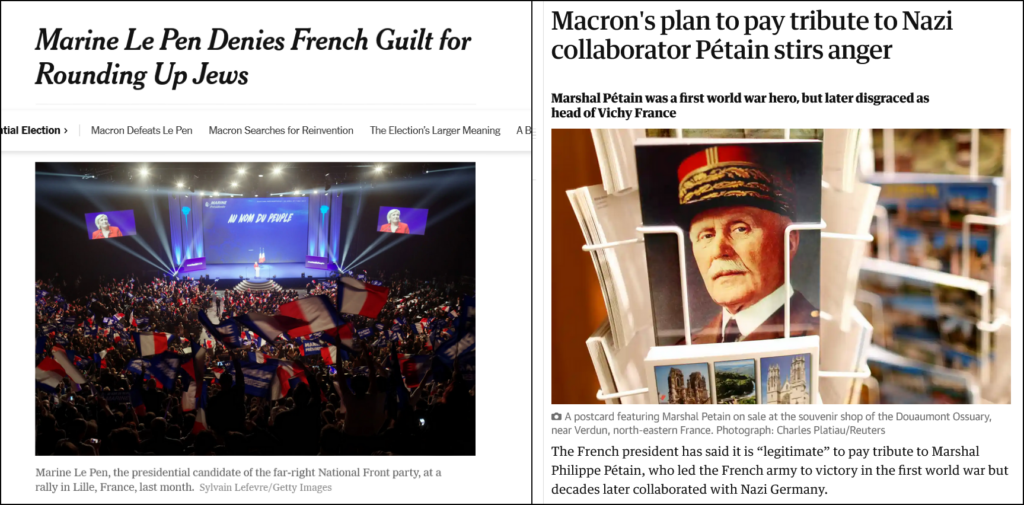
Left: The New York Times headline, April 10, 2017. Right: The Guardian headline, Nov. 7, 2018. Image by Forward collage
Although French President Emmanuel Macron recently won reelection, his far-right rival, Marine Le Pen, received 41% of the vote, with a broader geographic base than in their prior matchup. In 2017, Le Pen made headlines when she claimed the French bear no responsibility for deporting 76,000 Jews to their deaths, mostly to Auschwitz. The deportation was carried out by the Vichy Nazi puppet government of Philippe Pétain.
Even Macron, a moderate, had at one point considered staging ceremonies celebrating this Nazi collaborator, though he changed his mind after an international backlash. This shows how France has embraced once-unthinkable levels of whitewashing Nazi lackeys.
3 / 16 United States

Left: Philippe Pétain, left, with Hitler, Montoire-sur-le-Loir, France, Oct. 24, 1940 (Bundesarchiv, Bild 183-H25217 via Wikimedia Commons). Right: The Times of Israel headline, Jan. 15, 2018. Image by Forward collage
While there are no Pétain monuments in France, New York City’s “Canyon of Heroes” has plaques honoring Pétain as well as Vichy Prime Minister Pierre Laval.
City Hall initially promised to remove the plaques, but officials changed their minds. As of April 2022, the plaques remain, with no explanation that the men they honor were responsible for murdering 76,000 Jews.
4 / 16 Croatia
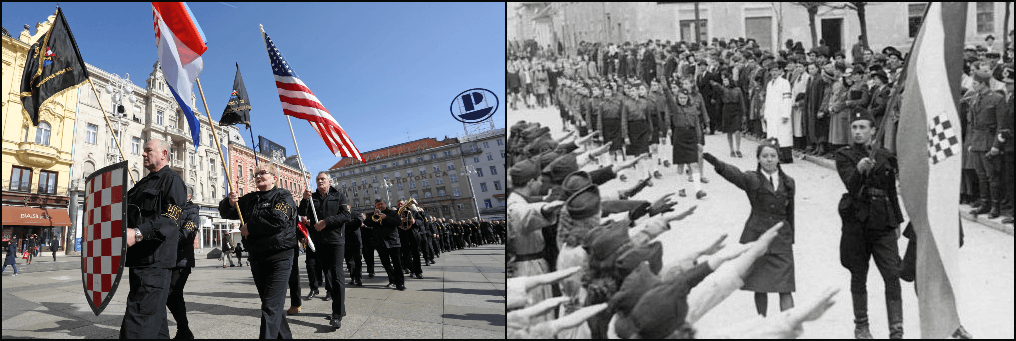
Left: Far-right march with Ustasha symbols, Zagreb, Feb. 26, 2017 (Stringer/AFP via Getty Images). Right: Ustasha rally, Zagreb, 1941. Image by Forward collage
The Indigenous Croatian Party of Rights staged a march in Zagreb in 2017 in support of U.S. President Donald Trump. They carried symbols of the Ustasha, a Nazi-allied regime that slaughtered hundreds of thousands of Jews, Roma and Serbs. The pro-Trump march echoed the fascist Ustasha parades held during World War II.
5 / 16

Left: Participants attend a commemoration rally at the Loibacher Feld for slain Ustasha members, Bleiburg, May 12, 2018 (Gert Eggenberger/AFP via Getty Images). Right: Croatian dictator and major Holocaust perpetrator Ante Pavelić salutes members of parliament, Zagreb, February, 1942 (National Digital Archives Poland via Wikimedia Commons) Image by Forward collage
Croatia has been awash with Holocaust revisionism honoring the Ustasha. The country has streets named for war criminals and senior members of the Nazi collaborator government. Ustasha supporters hold annual commemoration ceremonies in nearby Austria in honor of slain World War II figures.
Ustasha flags and symbols are now a staple of far-right marches, even ones having nothing to do with the war. During the last World Cup, Croatia’s national soccer team was rocked by a scandal due to its ties to Ustasha fans.
6 / 16 Germany

Left: People take part in the Dresden Memorial March held by the far-right under the title of 'Action Alliance against Forgetting,' Feb. 13, 2022 in Dresden (Craig Stennett/Getty Images). Right: The AP via the Times of Israel headline, April 28, 2018. Image by Forward collage
Every year, German neo-Nazis gather for a commemoration of the 1945 firebombing of Dresden. And in 2018, hundreds flooded central Berlin in an event honoring top Third Reich figure Rudolf Hess.
7 / 16
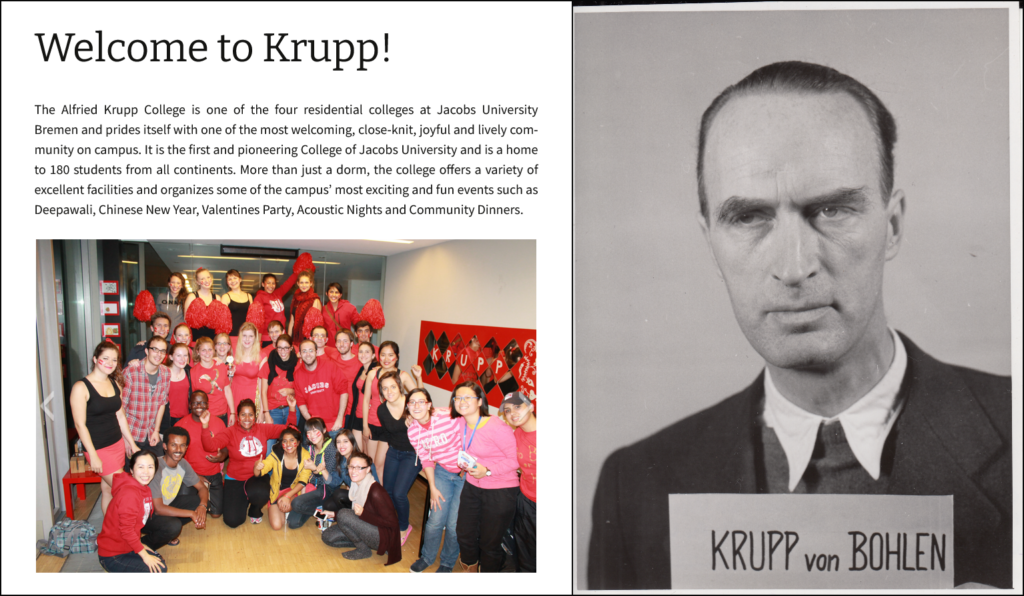
Left: Krupp College homepage. Right: Alfried Krupp mugshot from the Office of Military Government for Germany (U.S.), Office of the Chief of Counsel for War Crimes (National Archives at College Park – Still Pictures via Wikimedia Commons). Image by Forward collage
Alfried Krupp was convicted of war crimes at Nuremberg. His company had a factory in Auschwitz and used around 100,000 slave laborers, including children.
After the war, he was among a number of wealthy Nazi Party members and war profiteers who established charitable corporations in Germany. For example, in 2001, Jacobs University Bremen received 10 million deutschmarks from the Alfried Krupp von Bohlen und Halbach Foundation. The next year, the university opened what is now called the Alfried Krupp College.
8 / 16 Czech Republic

Left: Iron Cross memorial at Kořenov being rebuilt, 2011 (Josef Doškář). Right: the rebuilt cross (Google maps). Image by Forward collage
In 2011, a Czech group whose logo contains far-right symbols rebuilt a giant Iron Cross monument overlooking the Jizera mountains in Kořenov. The cross was originally erected to honor fallen Nazis in 1944; the governor of the Third Reich protectorate attended the opening ceremony.
In 1945, after liberation, Czechs tore down the monument. Today, it stands once again and has been used as a site of rituals by far-right groups.
See more of the Czech Republic’s Nazi-collaborator monuments.
9 / 16 Lithuania

Left: “We Know Our Heroes” banner at far-right march, Kaunas, Feb. 16, 2016 (Defending History). Right: The New Yorker headline, Dec. 15, 2017. Image by Forward collage
“We Know Our Heroes” proclaimed a banner featuring Nazi collaborators and Holocaust perpetrators at a 2016 march in Kaunas, Lithuania. These individuals have been glorified all over Lithuania and beyond; one even has a memorial in the U.S.
Lithuania’s state-sponsored Holocaust revisionism extends into harassing and silencing scholars – in 2017, a prominent Lithuanian writer had her career destroyed for daring to speak about Lithuanian collaborators.
10 / 16

Left: Kazys Škirpa (middle) meeting with Hitler (Defending History). Right: Right: banner with Škirpa as Pepe the Frog at far-right march, Kaunas, Feb. 1, 2017 (Defending History). Image by Forward collage
Another banner from a 2017 march in Kaunas shows Nazi collaborator Kazys Škirpa as the popular far-right meme Pepe the Frog, connecting an ally of Adolf Hitler to today’s ultranationalist culture. Skirpa’s organization, the Lithuanian Activist Front, was partly responsible for the extermination of about 95% of Lithuania’s Jews during the Holocaust.
11 / 16 Italy
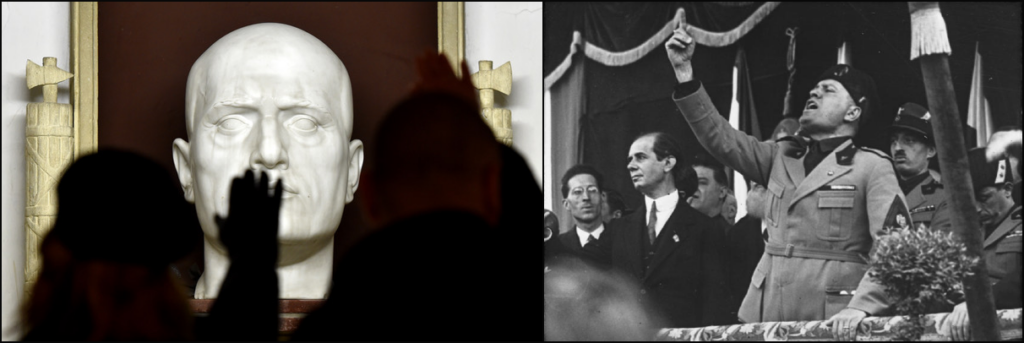
Left: far-right salutes at Mussolini's tomb during rally in his honor, April 24, 2016 (Tiziana Fabi/AFP via Getty Images). Right: Mussolini at the Duomo Square in Milan, May 1930 (Bundesarchiv, Bild 102-09844 via Wikimedia Commons). Image by Forward collage
The cult around fascist dictator Benito Mussolini has been growing in Italy. The country has seen a rise in far-right tourism centered on Mussolini-themed locales. Rome itself still bears numerous monuments to the dictator; streets honoring other fascists are also prevalent across the land.
12 / 16 Ukraine

Left: Far-right march in honor of Stepan Bandera’s 112th birthday, Kyiv, Jan. 1, 2021 (Genya Savilov/AFP via Getty Images). Right: Bandera bust (third from left), Baraboo, Wisconsin (Eduard Dolinsky). Image by Forward collage
Every New Year’s Day, supporters of Nazi collaborator Stepan Bandera gather for a torchlight march in Kyiv. Russian President Vladimir Putin has cited Ukraine’s glorification of Bandera and other collaborators as a pretext for the current war.
Monuments to Bandera monuments can also be found in the United States, including a bust in Baraboo, Wisconsin.
13 / 16
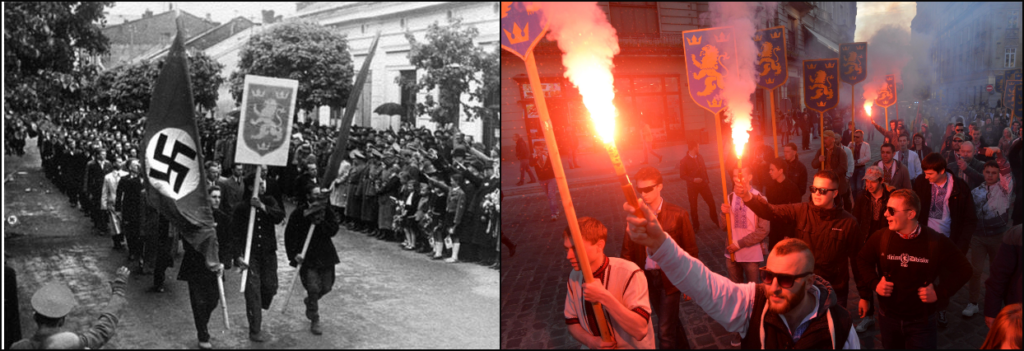
Left: SS Galichina recruitment march, most likely in Stanislaviv (now Ivano-Frankivsk), 1943. Right: neo-Nazi march on the 73rd anniversary of SS Galichina’s founding, L’viv, April 28, 2016 (Yuriy Dyachyshyn/AFP via Getty Images). Image by Forward collage
Some Ukrainians also honor the SS Galichina, a division of the military arm of the Nazi Party. SS Galichina’s lion-and-crowns insignia can be seen both at a recruiting march for the unit’s formation as well as modern commemorations of the division’s founding.
14 / 16 Hungary

Left, Miklós Horthy, Košice, Nov. 11, 1938. Right: March of the far-right “Our Homeland Movement” party commemorating the 100th anniversary of Horthy’s ascent to power, Budapest, March 1, 2020 (Attila Kisbenedek/AFP via Getty Images). Image by Forward collage
Hungary has been at the forefront of Holocaust revisionism, whitewashing its legacy as a Nazi collaborator state responsible for the murder of hundreds of thousands of Jews. That has only increased under Prime Minister Viktor Orban, a right-wing populist with a history of antisemitism.
There are now elaborate marches and ceremonies glorifying World War II despot Miklós Horthy, a Hitler ally. In 2020, the ultranationalist “Our Homeland Movement” party commemorated the 100th anniversary of Horthy riding into Budapest to seize power.
Also in Budapest, neo-Nazis from across Europe gather every Feb. 11 to commemorate a last stand of Axis forces, including the Arrow Cross Hungarian fascists who had massacred the city’s Jews. Hungary’s new Arrow Cross fascist party was founded on February 11.
15 / 16 Slovakia
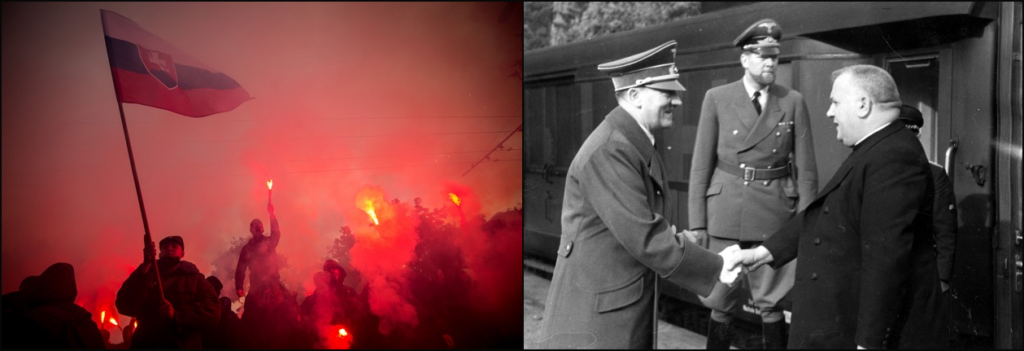
Left: members of Marian Kotleba's party protest against COVID measures, Bratislava, Oct. 17, 2020 (Vladimir Simicek/AFP via Getty Images). Right: Jozef Tiso with Hitler, Berlin, October, 1942 (Wikimedia Commons). Image by Forward collage
In 2020, the neo-Nazi party of Marian Kotleba gained seats in the Slovakian parliament. Kotleba’s party venerates World War II leader Jozef Tiso, a Hitler puppet responsible for deporting Jews to their deaths; after the war, Tiso was hanged for crimes against humanity.
16 / 16 Latvia

Left: Latvian SS volunteers parade, Riga, Dec. 2, 1943 (Bundesarchiv, Bild 183-J16133 via Wikimedia Commons). Right: Latvian SS veterans and their relatives march in a parade celebrating the Latvian Legion, March 16, 2012 (Ilmars Znotins/AFP via Getty Images). Image by Forward collage
A celebratory aura couching a dark past descends on Riga every year during the commemoration of Latvian Legion veterans — SS fighters, many of whom participated in the Holocaust.
The Forward is free to read, but it isn’t free to produce

I hope you appreciated this article. Before you go, I’d like to ask you to please support the Forward.
Now more than ever, American Jews need independent news they can trust, with reporting driven by truth, not ideology. We serve you, not any ideological agenda.
At a time when other newsrooms are closing or cutting back, the Forward has removed its paywall and invested additional resources to report on the ground from Israel and around the U.S. on the impact of the war, rising antisemitism and polarized discourse.
This is a great time to support independent Jewish journalism you rely on. Make a gift today!
— Rachel Fishman Feddersen, Publisher and CEO
Support our mission to tell the Jewish story fully and fairly.
Most Popular
- 1

Fast Forward Ye debuts ‘Heil Hitler’ music video that includes a sample of a Hitler speech
- 2

Opinion It looks like Israel totally underestimated Trump
- 3

Culture Cardinals are Catholic, not Jewish — so why do they all wear yarmulkes?
- 4

Fast Forward Student suspended for ‘F— the Jews’ video defends himself on antisemitic podcast
In Case You Missed It
-

Culture How one Jewish woman fought the Nazis — and helped found a new Italian republic
-

Opinion It looks like Israel totally underestimated Trump
-
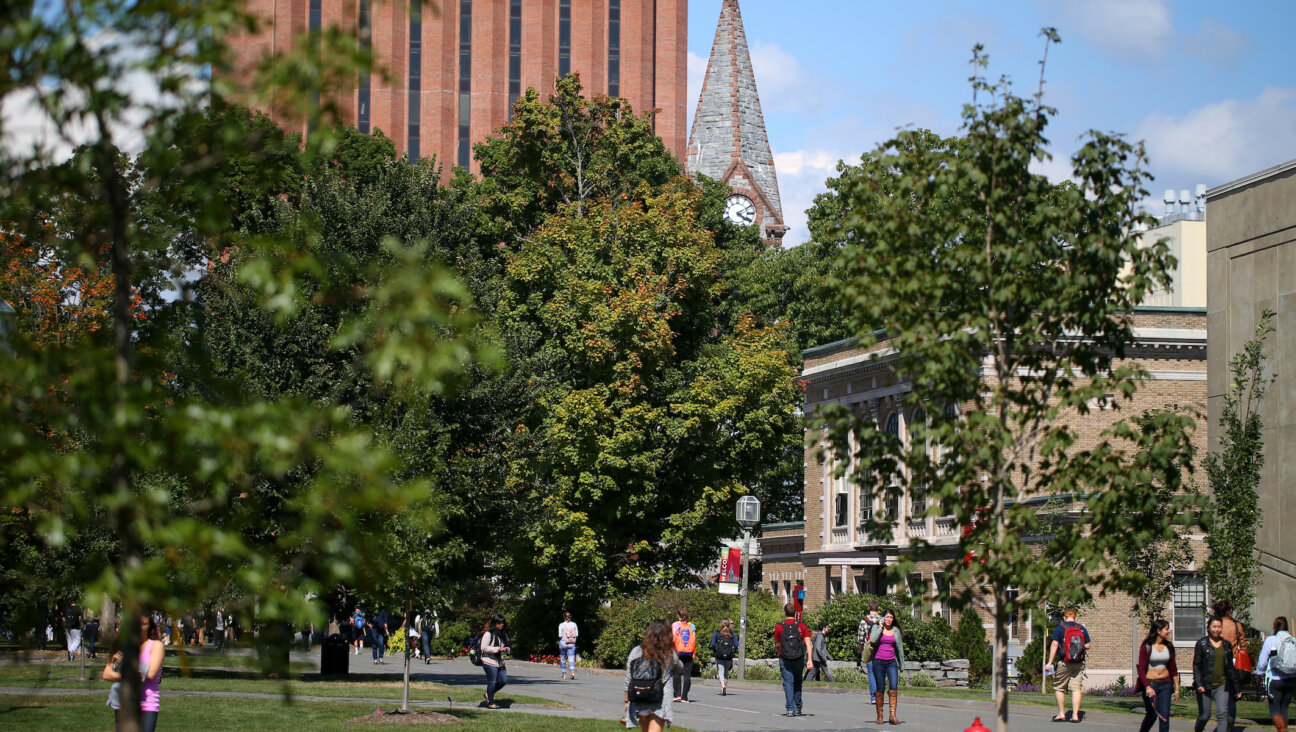
Fast Forward Betar ‘almost exclusively triggered’ former student’s detention, judge says
-

Fast Forward ‘Honey, he’s had enough of you’: Trump’s Middle East moves increasingly appear to sideline Israel
-
Shop the Forward Store
100% of profits support our journalism
Republish This Story
Please read before republishing
We’re happy to make this story available to republish for free, unless it originated with JTA, Haaretz or another publication (as indicated on the article) and as long as you follow our guidelines.
You must comply with the following:
- Credit the Forward
- Retain our pixel
- Preserve our canonical link in Google search
- Add a noindex tag in Google search
See our full guidelines for more information, and this guide for detail about canonical URLs.
To republish, copy the HTML by clicking on the yellow button to the right; it includes our tracking pixel, all paragraph styles and hyperlinks, the author byline and credit to the Forward. It does not include images; to avoid copyright violations, you must add them manually, following our guidelines. Please email us at [email protected], subject line “republish,” with any questions or to let us know what stories you’re picking up.









